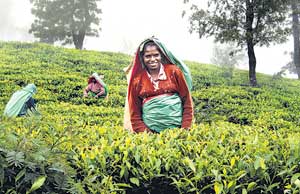
Tea exports expected to remain strong in second quarter
The second quarter of this year is expected to see strong performance from the tea sector with high production supported by robust export demand. Although prices at public auctions for high and mid grown teas are currently showing a seasonal downturn, tea exports and production are expected to be favourable. The short Vesak week saw only a one-day public auction. However, last week’s ex-estate catalogues carried 1.5 million kgs of tea. This is the largest quantity on auction since May 2005. Meanwhile, prices dropped sharply for high and mid grown teas. The price downturn is expected to last until mid-second quarter. “We won’t see a recovery until mid-second quarter. Most gains in the first quarter will be all but wiped out with the price reduction. So during this period, when production is high, estates will be hard pressed to sustain margins,” said the head of Asia Siyaka, Anil Cooke. Cooke took over as President and CEO of Asia Siyaka Commodities on April 1, after the retirement of Ravi Kumararatne. The company celebrated its 10 anniversary in March this year and is currently the third largest broker in the country. The commodity broker explained that prices for Sri Lankan tea increased at the start of this year due to lower production by Kenya. Average tea prices moved up from Rs 245.83 per kg in 2007 to Rs 332.26 per kg in the first quarter of this year. The Kenyan production shortfall was mainly enjoyed by high grown teas that saw prices jump from Rs 257.58 per kg to Rs 312.80 per kg in the first quarter of this year compared to the same period 2007. However, low grown teas saw the biggest price increase from Rs 247.84 per kg in 2007 to Rs 346.77 per kg in the first quarter of this year. High production The first quarter of this year also saw record productions. Total production hit 82.6 million kgs, making this the most successful first quarter for tea production in the country. The previous high for a first quarter production was 79.5 million kgs in 2001. Production continued upwards in April. The Tea Board recorded 29.5 million kgs of tea for the month of April, which is a 28% increase compared to April 2007. This puts total production for the year, until end-April, at 112 million kgs which is a 29% increase compared to the same period 2007. The trend is expected to hold into the rest of the year. “All things being equal, this year, the country could be on its way to exceed the record crop of 314.8 kg in 2005,” said Cooke. Strong exports Exports are also expected to do well in the second quarter. Sri Lanka exported 78.9 million kgs of tea to the world in the first quarter of the year that brought a record income of US$ 305 million. Last year, tea exports in the first quarter, brought in US$ 217 million and by the end of the year hit the US$ 1 billion mark. The forecast is favourable for this year as well. Strong exports of Sri Lankan tea, are expected to continue, despite worries of a global economic slowdown. Sri Lanka’s main export destinations, Russia and the CIS countries are seen as stable markets while the Middle East is seen as a growing market. “The oil producing countries will not be affected by increasing oil and gas prices. In the Middle East, there is also development activity and labour migration. This influx of labour also helps the Middle Eastern tea market to grow,” explained Cooke. Demand for low grown tea is expected to remain strong from Russia, CIS countries and the Middle East. “Traditionally tea consumption in our major export markets of Russia, CIS countries and the Middle east, reduces during the summer. But this year we are seeing very good demand and therefore, we expect prices to be relatively strong with some fluctuations in different grades catering to different markets,” said Cooke. The increasing global commodity prices have also worked in favour of Sri Lankan tea exports. “The world price increases have allowed supermarkets in more developed countries to increase the price of tea. These prices are unlikely to come down,” said Cooke. |
|
||||||
|
||||||
| || Front
Page | News
| Editorial
| Columns
| Sports
| Plus
| Financial
Times | International
| Mirror
| TV
Times | Funday Times || |
| |
Reproduction of articles permitted when used without any alterations to contents and a link to the source page.
|
© Copyright
2008 | Wijeya
Newspapers Ltd.Colombo. Sri Lanka. All Rights Reserved. |
